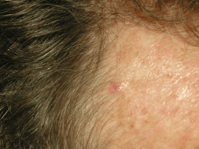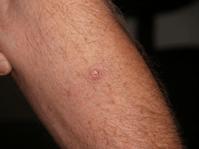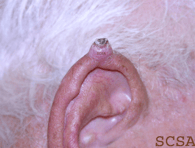Squamous cell carcinoma: An overview
Squamous cell carcinoma (SCC) is the second most common form of skin cancer. It arises from abnormal, uncontrolled growth of the skin’s squamous cells. While most SCCs can be successfully treated if caught early, more advanced tumours can lead to severe disfigurement, scarring, and spread into other areas of the body, causing death. Understanding the causes, risk factors and warning signs for SCC can help you spot these skin cancers early when they are easiest to treat.
What causes SCC?
Squamous cells are one of the three main types of cells in the top layer of the skin. They are flat cells that shed continuously as new ones form. SCCs occur when these cells are damaged or exposed to the sun’s ultraviolet (UV) radiation, which causes DNA damage and uncontrolled cell growth.
95% of SCCs are detected early, when they are easiest to treat. The remaining 5% of SCCs advance to a stage that is far more dangerous and challenging to treat.
What does SCC look like?
SCCs look different on everyone. They can appear as scaly red patches, open sores that won't heal, rough or thickened skin, wart-like lesions, or raised growths with a central dip. SCCs can sometimes crust, itch or bleed. While they usually occur on sun-exposed skin, they can also develop in any area of the body.
The below images are examples of real squamous cell carcinomas.



-1.jpg?width=199&name=Picture%204%20SCC%20(1)-1.jpg)
Is SCC dangerous?
While most SCCs can be successfully treated if caught early, untreated or advanced tumours can lead to significant disfigurement, scarring, and even death. SCCs can become invasive, grow into deeper layers of skin, and spread to other parts of the body. The longer an SCC is left untreated, the poorer the prognosis becomes.
Who is at risk of SCC?
Any of the below factors can put you at higher risk of developing SCC:
- A family or personal history of skin cancer
- UV exposure from the sun or tanning beds
- Age over 50
- Fair skin or light-coloured hair or eyes
- Male
- A compromised immune system
- Five or more sunburns
- Working outdoors
- Spending a lot of time in the sun
- Chronic infections and skin inflammation
- Skin precancers including actinic keratosis
- History of human papilloma virus (HPV)
To find out your skin cancer risk, take our quick quiz.
How can SCC be prevented?
Skin cancer is a largely preventable disease. You can protect yourself against developing SCC by adopting sun safe habits like wearing sunscreen, a hat, sunglasses, and long sleeves; seeking shade whenever you are outdoors; and avoiding going outside in UV peak times (usually between 10.00am – 3.00pm).
It’s also important to keep an eye on your own skin for anything new, changing or unusual, and get a professional skin cancer check at least once a year (or more often if you are at high risk of skin cancer).
Learn more about preventing skin cancer here.
How is SCC treated?
Most SCCs can be treated and cured if found early. The longer an SCC grows, the more invasive and difficult the treatment becomes. The treatment will depend on the size of the SCC, where it is located on your body, and certain other factors your Skin Cancer Doctor will discuss with you.
Treatment options for SCC can include:
- Curettage and cautery, where the cancer is scraped off and heat is applied to the skin's surface;
- Mohs surgery, in which a small amount of skin tissue is shaved off repeatedly until the margins come back clear of cancerous cells;
- Excision, where the SCC is surgically cut out;
- Radiation therapy, in which the cancer is destroyed with beams of intense energy;
- Photodynamic therapy, in which a special light and a topical cream are used in combination to kill cancer cells; and/or
- Topical creams, which are applied to the skin in cases of very superficial SCCs or in areas where it is difficult to perform surgery.
More advanced or metastatic (spreading) SCCs may require more extensive surgery, radiation therapy and/or immunotherapy.
Learn more about skin cancer treatments here.
